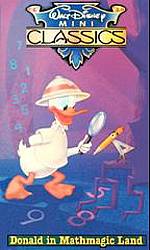Plot
The film begins with Donald Duck, holding a hunting rifle, as he passes through a doorway to find he has entered Mathmagic Land. This "mighty strange" fantasy land contains trees with square roots, a stream flowing with numbers, and a walking pencil that plays tic-tac-toe. A geometric bird recites (almost perfectly) the first 15 digits of pi. Donald soon hears the voice of the unseen "True Spirit of Adventure", who will guide him on his journey through "the wonderland of mathematics".
Donald is initially not interested in exploring this foreign land, believing that mathematics is just for "eggheads" until "Mr. Spirit" suggests a fascinating connection between math and music. Intrigued, Donald discovers the relationships between octaves and string length which form the musical scale of today. Next, Donald finds himself in ancient Greece, where Pythagoras and his contemporaries are discovering these same relationships. Pythagoras (on the harp), a flute player, and a double bass player hold a "jam session" which Donald joins after a few moments using a vase as a bongo drum. Pythagoras' mathematical discoveries are, as the Spirit explains, the basis of today's music, and that no type of music could have ever existed without "eggheads". The segment ends with a sequence of live-action musicians playing both jazz and classical music and Pythagoras' acquaintances magically disappearing.
After shaking hands with Pythagoras, who then vanishes, Donald finds on his hand a pentagram, the symbol of the secret Pythagorean society. The Spirit then shows Donald how the mysterious golden section appears in this ancient magic star. Next, the star itself is shown to contain the pattern for constructing golden rectangles many times over. According to the Spirit, the golden rectangle has influenced both ancient and modern cultures in many ways. Donald then learns how the golden rectangle appears in many ancient buildings, such as the Parthenon and the Notre Dame cathedral. Paintings such as the Mona Lisa and various sculptures such as the Venus de Milo contain several golden rectangles. The use of the golden rectangle is found in modern architecture, such as the United Nations building in New York City. Modern painters have also rediscovered the infinite mathematical magic of stars and golden rectangles.
The Spirit shows Donald how the golden rectangle and pentagram are even related to the human body and nature themselves. The human body itself contains the "ideal proportions" of the golden section. However, Donald, overinterpreting the Spirit's advice, tries to make his own cartoon body fit such a proportion, but his efforts are to no avail; he ends up "all pent up in a pentagon". The pentagram and pentagon are then shown to be found in many flowers and animals, such as the petunia, the star jasmine, the starfish, the waxflower. Then, with the help of the inside of a nautilus shell, the Spirit explains that the magic proportions of the golden section are often found in the spirals of nature's designs, quoting Pythagoras: "Everything is arranged according to number and mathematical shape."
Donald then learns that mathematics applies not only to nature, architecture, and music, but also to games that are played on geometrical surfaces, including chess, baseball, American football, basketball, hopscotch, and three-cushion billiard. In chess, Donald suggests the game checkers, but the Spirit does not pursue this option. Donald even volunteers the game tiddlywinks, but the Spirit also rejects this option. Instead, the Spirit challenges Donald Duck to the ancient and challenging game of chess, as made famous by Lewis Carroll's 1871 novel Through the Looking-Glass . In this exciting and imaginative scene, Carroll is portrayed as both a writer and a mathematician. Then, the extended billiards scene features a non-speaking live actor shows the calculations involved in the game's "diamond system", and Donald eventually learns how to do the right calculations to hit ten cushions all while needlessly making it tough for himself.
The Spirit then asks Donald to play a mental game, but he finds Donald's mind to be too cluttered with "Antiquated Ideas", "Bungling", "False Concepts", "Superstitions", and "Confusion". After some mental housecleaning, Donald plays with a circle and a triangle in his mind. He is then able to transform them into a sphere and a cone, and he proceeds to rediscover some of man's most useful past inventions, such as the wheel, train, magnifying glass, drill, spring, propeller, and telescope. Donald then discovers that pentagrams can be drawn inside each other indefinitely, almost as if by magic. In the end, he learns that numbers provide an avenue to consider the concept of infinity itself. The Spirit states that scientific knowledge and technological advances are unlimited, and the key to unlocking the doors of the future is mathematics. By the end of the film, Donald understands and appreciates the value of mathematics and the boundless powers of human imagination and invention. The film closes with a beautiful and inspiring quotation from Galileo Galilei: "Mathematics is the alphabet with which God has written the universe."

